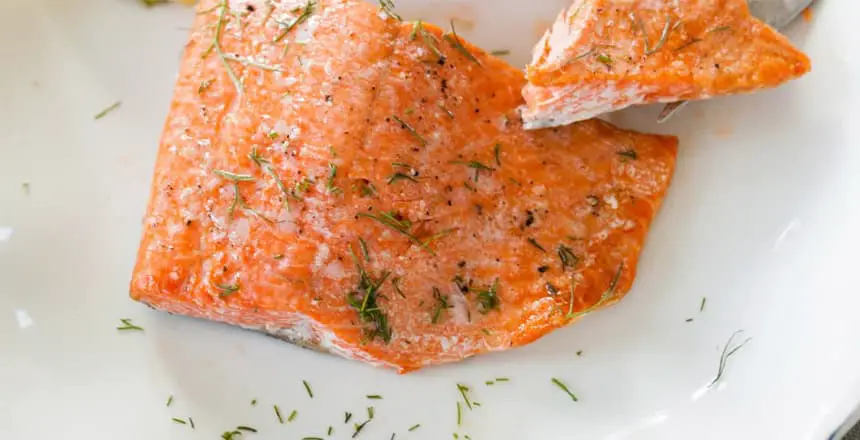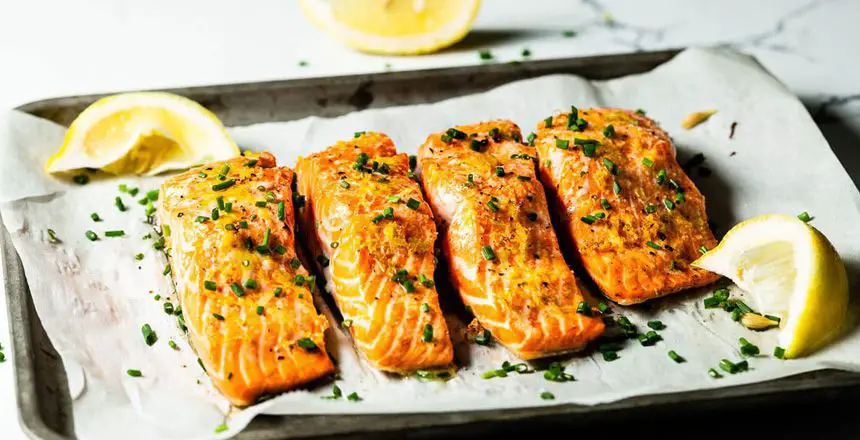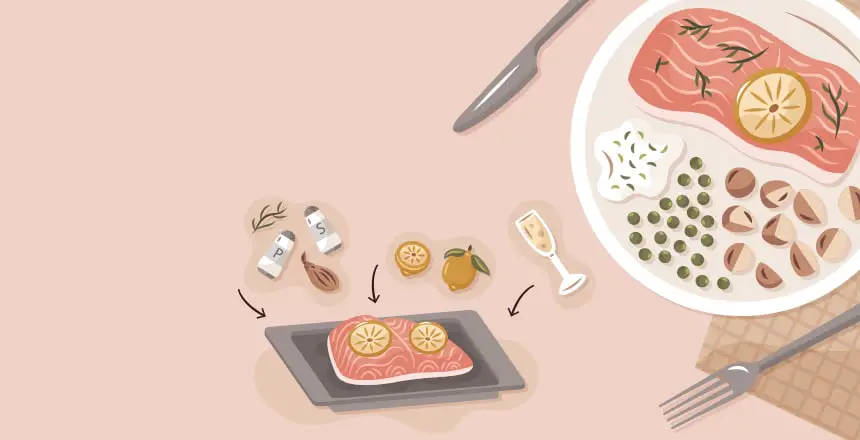If you’re looking for a delicious and healthy meal, salmon is an excellent choice. One of the easiest and most popular ways to cook salmon is in the oven, which is a simple and fuss-free method that produces tender and flavorful fish.
For a perfect oven-baked salmon, let’s discover how to cook salmon in the oven. We will take you through each step of the process, from selecting the right salmon to checking for doneness. So let’s roll up our sleeves, preheat the oven, and get started on cooking the perfect salmon dish.
Related:
- How Long to Cook Salmon Patties
- Is Smoked Salmon Cooked Or Raw
- How Long Does Cooked Salmon Last in the Fridge?
Contents
What’s the Best Temperature to Cook Salmon?

There is no one-size-fits-all answer to the best temperature to bake salmon, as it can depend on personal preferences and the desired texture and flavor of the salmon.
While 425°F (215°C) can produce crispy skin and quick cooking times, higher temperatures can also risk overcooking or drying out the salmon. If you would like to use a gentler approach to baking salmon, you can set the temperature to 350°F (175°C) and bake it for approximately 20-25 minutes or until it is fully cooked.
However, as a general guideline, a temperature of 400°F (205°C) is commonly recommended for baking salmon, as it allows for even cooking and moisture retention while still producing a slightly crisp exterior. This temperature should result in a cooking time of about 15-20 minutes for a 1-inch thick fillet.
Ultimately, the best temperature for baking salmon will depend on individual preference and the specific recipe being used. It’s important to always check the internal temperature of the salmon using a meat thermometer and make sure it reaches a safe temperature of 165°F before serving.
How Long Does It Take To Cook Salmon In the Oven?

The cooking time for salmon in the oven can vary depending on several factors, such as the size and thickness of the salmon fillet or steak, as well as the desired level of doneness. However, here are some general guidelines that are reasonable depending on the different temperatures:
- When baked at a temperature of 350°F (175°C), a salmon fillet usually requires around 25 minutes to cook. Once fully cooked, the thickest part of the fillet should be able to flake apart easily.
- If baked at 400°F (205°C), a piece of salmon typically needs about 15 minutes to cook, or until the temperature at its thickest, innermost part reaches 135 degrees.
- To achieve the most tender and buttery fillets, baking salmon at 425°F (215°C) requires approximately four to six minutes per half-inch of thickness. Since most fillets are typically about one inch thick at the thickest point, baking until the salmon is fully cooked should take approximately 12 to 15 minutes.
To ensure that the salmon is fully cooked and safe to eat, it’s recommended to use a meat thermometer to check the internal temperature. The salmon should reach a temperature of 145°F (63°C) before it is removed from the oven.
How to Cook Salmon in the Oven?
Equipment
- Oven
- Baking sheet or baking dish
Ingredients:
- 1 pound salmon fillet
- Salt and pepper
- Olive oil or cooking spray
- Lemon wedges (optional)
Detailed Guide
Step 1: Prep the salmon
Rinse it under cold water, remove any bones, season it with salt and pepper (you can add garlic, onion,… or any marinades if you liked), drizzle it with olive oil or spray it with cooking spray, and let it rest for a few minutes before cooking it in the oven according to your recipe.
Step 2: Preheat the oven to 400°F (200°C).
Preheating the oven is an important step in cooking salmon (or any other dish) in the oven. It ensures that the oven reaches the desired temperature before you begin cooking, which helps to ensure even cooking and a properly cooked dish. In the case of salmon, preheating the oven to 400°F (200°C) is a common temperature that works well for most recipes.
Step 3: Place the salmon
Place the salmon fillet on the prepared baking sheet or baking dish, lined with aluminum foil.
Step 4: Bake the salmon
Bake the salmon in the preheated oven for 12-15 minutes, depending on the thickness of the fillet. In addition, If you like the crispy exterior, you can broil it for 3-4 minutes after baking.
Step 5: Serve the oven-baked salmon
Once your salmon is done, serve it with some unsalted butter, lemon, garnish, and dried parsley if you like.
Watch this video for an easier guide:
Paper: Foil or Parchment?
Both foil and parchment paper can be used for baking salmon, but they have different advantages and disadvantages.
Foil is a good choice if you want to create a tightly sealed packet around the salmon, which helps to trap moisture and flavor. However, if the salmon is in direct contact with the foil, it can sometimes stick and tear when you try to remove it, which can be frustrating. Additionally, some people are concerned about the potential health risks associated with cooking with aluminum foil.
Parchment paper is a good alternative to foil as it allows the salmon to cook evenly without sticking, and it also makes for easy cleanup since you can just discard the paper afterward. However, parchment paper is not as effective at trapping moisture and can sometimes result in drier salmon if you’re not careful.
Ultimately, whether you choose foil or parchment paper will depend on your personal preference and the specific recipe you’re using. If you’re looking for a simple and foolproof way to bake salmon, parchment paper is a good choice. If you want to create a tightly sealed packet around the salmon and don’t mind the potential sticking issue, foil can be a good option.
What to Serve With Salmon
Salmon is a versatile fish that pairs well with a variety of side dishes. Here are some options to consider:
- Roasted vegetables – roasted asparagus, Brussels sprouts, carrots, or broccoli complement the flavors of salmon well and provide a healthy dose of nutrients.
- Rice – steamed white or brown rice is a simple and classic side dish that goes well with salmon. You could also try flavored rice, such as lemon herb or garlic and butter.
- Quinoa – this grain is high in protein and complements the richness of salmon. Try cooking it with herbs and spices to add flavor.
- Salad – a light salad can provide a refreshing contrast to the rich flavors of salmon. Try a spinach and strawberry salad, mixed greens with citrus dressing, or a cucumber and tomato salad.
- Potatoes – roasted, mashed, or boiled potatoes are a hearty and satisfying side dish that pairs well with salmon.
How to season baked salmon?
Baked salmon is a versatile and delicious dish that can be seasoned in many different ways to suit your taste.
You can choose from a variety of flavors and ingredients to highlight the natural taste of the fish. Some popular options for seasoning baked salmon include lemon and herb, garlic and butter, honey mustard, Asian-inspired glazes, Cajun seasoning, Mediterranean-inspired toppings, and pesto. When seasoning your salmon, it’s important to avoid overpowering its delicate flavor by using a light hand.
Alternatively, you can keep things simple with a basic combination of salt, pepper, olive oil, oregano, chili powder, and cumin to enhance the natural flavor of the fish. Regardless of the seasoning you choose, baked salmon is a healthy and satisfying meal that can be enjoyed in a variety of ways.
FAQs About Cooked Salmon
How Long to Cook Salmon at 425?
At 425°F (215°C), you’ll want to aim for about four to six minutes per half-inch of thickness for the most tender and buttery fillets possible. Since most salmon fillets are about one inch thick in the thickest part, bake until the salmon is cooked through, which typically takes about 12 to 15 minutes.
Should I Cook Salmon at 350 or 450?
The ideal temperature for cooking salmon depends on the specific recipe and cooking method you’re using.
If you are baking salmon in the oven, a temperature of 350°F (175°C) is ideal if you prefer a milder method. This will take about 25 minutes for a fillet to cook through.
If you want a quicker cooking time and prefer your salmon with crispy skin, you can bake it at 450°F (230°C) for about 12-15 minutes per inch of thickness.
Is It Better to Bake Salmon at 375 or 400?
Baking at 375°F will typically take a bit longer than baking at 400°F. In addition, baking with higher temperate will produce a nicely browned exterior and a slightly firmer texture.
Do You Flip Salmon When Cooking in the Oven?
If the salmon has skin on one side, it is not necessary to flip it during baking. The skin can help protect the flesh from drying out and also provides a crispy texture.
Do You Bake Salmon Covered or Uncovered?
It is recommended to bake salmon uncovered at a high temperature (around 400-425°F/ 205-218°C) for a shorter period of time to ensure the fish is cooked through but still moist and flavorful.
Conclusion
In conclusion, learning how to cook salmon in the oven is a great skill to have in your cooking repertoire. It’s a simple and healthy way to prepare a delicious and nutritious meal for yourself, your family, or your guests.
By following the steps outlined in this guide, you can easily prep and season your salmon fillets and bake them in the oven to perfection. So go ahead and try to cook salmon in the oven for a tasty meal that’s sure to impress!
